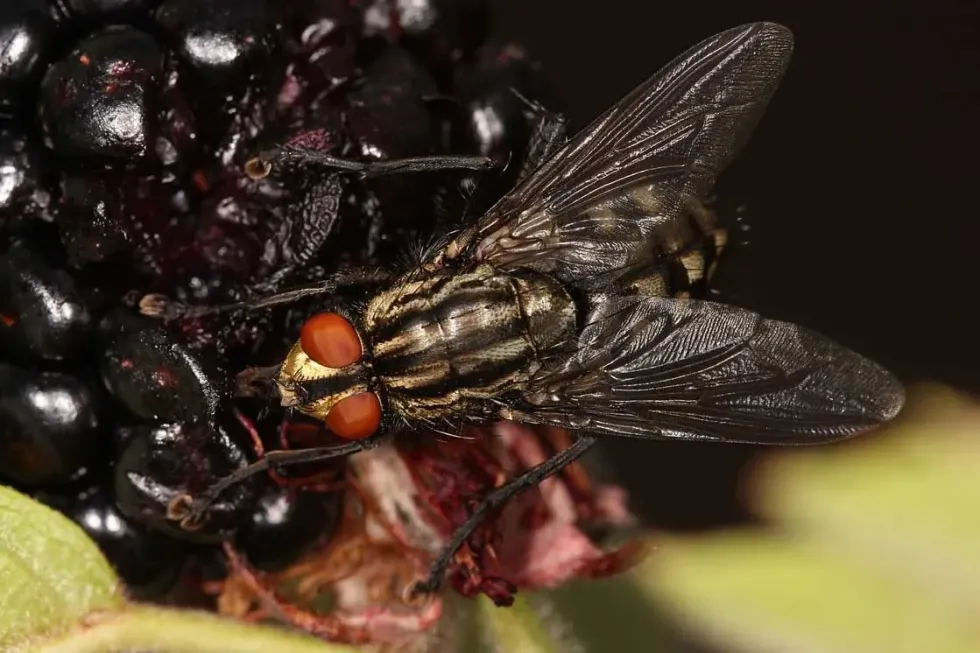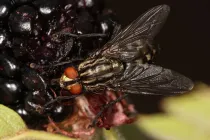We are surrounded by these absurd and annoying insects from the family Sarcophagidae every day. Yet, we seem to disregard exactly how unhealthy and unhygienic these flesh flies are. Having become more and more common in constantly growing urban and rural areas, the flesh fly’s habitat and breeding grounds keep increasing thus helping its population to grow.
Flesh flies are not limited to only one species. In fact, to date, there exist over 2,500 identified species. Flies of this species are distributed all over the world in abundance.
However, flesh flies could have some interesting forensic uses. Keep reading to find out more about the flesh fly life cycle. After reading these flesh fly facts, do check our other articles on the red paper wasp and the mayfly.
Flesh Fly Interesting Facts
What type of animal is a flesh fly?
A flesh fly (Sarcophaga bercaea) is an insect belonging to the phylum of Arthropoda and has over 2500 species existing in the world.
What class of animal does a flesh fly belong to?
The flesh fly (Sarcophaga bercaea) is an insect that is classified under the phylum of Arthropoda and class Insecta.
How many flesh flies are there in the world?
Scientists and biologists have not been able to offer an exact number of flesh flies in the world because it is very hard to actually track and quantify tiny insects. However, these insects are classified as Not Extinct with respect to their conservation status.
Where does a flesh fly live?
A flesh fly lives in houses and urban settlements which are fairly dirty or unhygienic.
What is a flesh fly's habitat?
A flesh fly's habitat is essentially any area that has an abundance or presence of garbage. Flesh flies thrive on human bodily secretions, excrement, rotting organic waste, carrion, and so on. These houseflies also feast on nectar from flowers.
Who do flesh flies live with?
Flesh flies are usually found alone.
However, in case there is potential breeding and feeding ground for them, such as a corpse or rotting foods or heaps of garbage, these flies will swarm in large numbers over there.
This is one of the main reasons why it is advisable to conduct a thorough sweep of your house for dead or rotten things in places that are not directly visible to the eye if you notice a substantial increase in the number of flesh flies in your house or your surroundings.
How long does a flesh fly live?
The flesh fly’s life cycle has four distinct stages as follows, the egg, larva, pupa, and adult stages. These four stages, referred to as metamorphosis, can last for about 20 days. After having grown into an adult flesh fly, its average life cycle is around 15-20 days.
How do they reproduce?
The Sarcophaga genus is known for its ability to lay its eggs and incubate them until they hatch into larvae inside their bodies. This ability of flesh flies is referred to as larviparous.
The adult flesh flies incubate the eggs inside its body until eggs hatch in larvae and lay their eggs at the pupal stage.
Following this, it finds a nesting ground that has an abundance of feeding material for the larvae stage. Females of this species have been known to deposit 20 to 40 flesh fly larvae at a single go, but that number can be as high as 325.
The female gives live birth to larvae after the eggs hatch inside her abdomen.
These larvae turn into pupae for about two weeks, after which, these pupae develop into adult flesh flies. Flesh flies have an extremely short lifespan at around 15-21 days during which it completes all the stages of its life cycle.
What is their conservation status?
Flesh flies are classified as of Least Concern with respect to their conservation status as plenty of these pests who feed on dead animals are present across the world. The only threat for them is from pest control measures taken by pest control professionals in case of infestation of this species.
Flesh Fly Fun Facts
What do flesh flies look like?

Adult flesh flies are tiny insects whose most distinguishing characteristic is their set of eyes. Their eyes are bright red in color and have a smooth texture.
Their abdominal regions have bristles and their thorax is uniquely patterned with black and grey vertical stripes running across them. The unique aspects of the flesh fly pattern of appearance are the three black stripes on the thorax and checkerboard pattern on top of the abdomen.
How cute are they?
Flesh flies are not cute insects at all. On the contrary, this species of flies is quite unhygienic and disgusting to be around owing to their habitat preferences and origins. Even the flesh fly larvae are not cute in any manner whatsoever.
How do they communicate?
It is yet unclear and unknown as to how exactly flesh flies communicate with one another. However, some research shows us that flesh flies are able to listen to their surroundings and that their ears are usually proportionate to their physical growth.
How big is a flesh fly?
An adult flesh fly can grow, on average, to be as big as 0.39-0.52 in. This means that a fresh fly would be just about as big as a human being’s nail. A flesh fly larva is even smaller making it difficult to hold, measure, or weigh.
How fast can a flesh fly fly?
There are no specific details about the flying speed of a blowfly but experts guess that a flesh fly can reach almost two meters per second. But even this speed is not enough to save it from pest control professionals.
How much does a flesh fly weigh?
The flesh fly is estimated to have a bodyweight in the range of 0.17-0.35 oz.
What are their male and female names of the species?
There are no specific names assigned to male and female flesh flies. Flesh fly adult species are simply referred to by the generic name assigned to their species; that is, the male members are referred to as male flesh fly while the female is known as female flesh fly.
What would you call a baby flesh fly?
A flesh fly baby is known as a flesh fly juvenile.
What do they eat?
Flesh flies are scavengers who feed primarily on flesh. Flesh fly diet can include things like dead animals (carrion), rotting fruit, garbage, open wounds and human excreta, organic wastes, and garbage in general. The flesh fly maggots can feed on other larvae as well as excrement and decaying matter.
Are they dangerous?
Flesh flies are not typically dangerous insects. Flesh fly bites can result in an allergic reaction known as flesh fly intestine infection that makes the site of the bite swell up a little or ooze a little pus.
However, these insects are carriers of germs, pathogens, and diseases owing to their habitat preferences.
Hence, you must use a special flesh fly trap to get rid of these annoying adult flies or use pest control measures. Flesh fly pests have been known to spread leprosy bacilli and other poisons for animals and humans, hence necessitating pest control in case of severe infestation.
Would they make a good pet?
No, flesh flies would not make for good pets since this house fly is a pathogen-carrying pest that likes to settle in unhygienic places.
Did you know...
The way for flesh fly identification is to distinguish between a male and female by dissecting their genitals.
Forensic entomologists use the flesh fly maggots/larvae for determining the time of death or identification of the person in different criminal cases. They can determine the time of death and help in the identification of a corpse against the list of missing persons.
How far away can a flesh fly smell dead flesh?
Flesh flies can smell dead flesh from roughly four or five miles away when it is time for them to feed. There can be a competition between flesh fly vs cluster fly and flesh fly vs housefly when it comes to their smelling senses.
Do flesh flies transmit diseases?
Yes, flesh flies are pests who are known carriers of diseases, germs, and pathogens. These pests spread diseases such as leprosy, E. coli, streptococcus, salmonella, and so on.
Here at Kidadl, we have carefully created lots of interesting family-friendly animal facts for everyone to discover! Learn more about some other arthropods including the panda ant and the mud dauber wasp.
You can even occupy yourself at home by drawing one of our flesh fly coloring pages.










